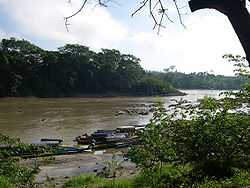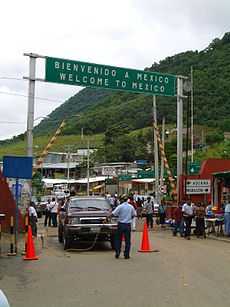Guatemala–Mexico border
The Guatemala–Mexico border is the international border between Guatemala and Mexico. It measures 871 km (541 mi) and runs between north and west Guatemala (the Guatemalan departments of San Marcos, Huehuetenango, El Quiché and El Petén) and the Mexican states of Quintana Roo, Campeche, Tabasco and Chiapas. The border includes stretches of the Usumacinta River, the Salinas River, and the Suchiate River.



It is across this border that most of the commerce between Mexico and Guatemala and the rest of Central America takes place. In some models, this border represents the division between the Central American region of North America and North America proper.
History
In 1881, problems arose for Guatemala when President Justo Rufino Barrios claimed lands Soconusco and Chiapas. The initial position of the Government of Mexico was not to accept discussion about their rights in that region. However, from 1882 began talks to resolve the problem between Matías Romero and Justo Rufino at The Winch at Hacienda de Barrios (Soconusco), where both had possessions. They decided to go to arbitration in the United States. The preliminary agreement was signed in New York on August 12 of 1882, and it was stated that: "The Republic of Guatemala dispenses with the argument that has held about his rights to the territory of Chiapas and Soconusco department." The position of Mexico is well seated in their rights of those territories. The final boundary treaty was signed in Mexico City on September 27 of 1882. In his first article provides that: "The Republic of Guatemala forever renounce rights that judges have on the territory of the State of Chiapas and Soconusco your district, and therefore considers the territory as part of the United Mexican States." As for the delineation of the border itself, Mexico and Guatemala agreed to use straight lines between key points known and accepted by both countries. The measurement and demarcation work was completed in 1902. Soconusco in Guatemala advanced to the river Suchiate and Mexico received the county of Motozintla.
Immigration issues
In 2006, Joseph Contreras profiled the issue of Guatemalan immigrants illegally entering Mexico for Newsweek magazine and pointed out that while Mexican president Vicente Fox demanded that the United States grant legal residency to millions of undocumented Mexican immigrants, Mexico had only granted legal status to 15,000 undocumented immigrants. Additionally, Contreras found that at coffee farms in the Mexican state Chiapas, "40,000 Guatemalan field hands endure backbreaking jobs and squalid living conditions to earn roughly [US]$3.50 a day" and that some farmers "even deduct the cost of room and board from that amount."[1] The Mexican National Institute of Migration estimated that 400,235 people crossed the border illegally every year and that around 150,000 of them intended to enter the United States.[2]
Cities and Border crossing
Guatemala and Mexico had 10 formal border crossings in 2004:
- Ciudad Hidalgo, Chiapas - Ciudad Tecún Umán, San Marcos
- Talismán, Chiapas - El Carmen, San Marcos
- Union Juárez, Chiapas - Toquían Grande, San Marcos
- Mazapa de Madero, Chiapas- Sibinal, San Marcos
- Ciudad Cuahtemoc, Chiapas - La Mesilla, Huehuetenango
- Carmen Xhán, Chiapas - Gracias a Dios, Huehuetenango
- Nuevo Orizaba, Chiapas - Ingenieros, El Quiché
- Frontera Corozal, Chiapas - Bethel, El Petén
- El Ceibo, Tabasco - El Ceibo, El Petén
- El Martillo, Tabasco - El Naranjo, El Petén
References
- ↑ Contreras, Joseph (June 5, 2006), "Stepping Over the Line", Newsweek 147 (23): 72
- ↑ Gorney, Cynthia (February 2008), "Mexico's Other Border", National Geographic 213 (2): 60–79